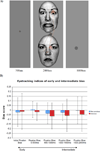Sustained neural alterations in anxious youth performing an attentional bias task: a pupilometry study
- PMID: 22700457
- PMCID: PMC3480547
- DOI: 10.1002/da.21966
Sustained neural alterations in anxious youth performing an attentional bias task: a pupilometry study
Abstract
Background: Biased attention patterns have been observed at early (16-500 ms poststimulus onset) and intermediate (1,500-4,000 ms post-onset) time points in anxious youth, but it is unclear whether a more sustained form of neural attentional bias, persisting well beyond the time frame of stimulus presentation and behavioral response, is also apparent. We investigated early, intermediate, and sustained forms of bias using behavioral measures and pupillary reactivity, an index of cognitive and affective load, to gain insight into potential neurocognitive targets for early intervention.
Method: Twenty nonanxious youth and 74 youth with generalized anxiety disorder (GAD), separation anxiety disorder (SAD), and/or social phobia (SP) completed a dot-probe task, which requires participants to respond to a dot replacing either a neutral or fearful face. Emotional faces were presented for short/early (200 ms) or intermediate (2 s) intervals and followed by a sustained (up to 10.5 s) poststimulus interval. Pupil dilation, gaze direction, and reaction times (RTs) were measured during task completion.
Results: Early and intermediate vigilance patterns in RTs and an avoidant pattern in gaze direction were observed in all participants irrespective of anxiety. Sustained pupil dilation in anxious youth was observed on trials in which the dot replaced fearful faces, along with an inflexible pattern of pupillary responding in comparison to controls.
Conclusion: Sustained cognitive-affective load following emotional face viewing is altered and inflexible in anxious youth. These prolonged alterations extend well beyond the time frame of behavioral attentional bias and may indicate inflexible and insufficient sustained cognitive control. Early interventions targeting these alterations could improve long-term mental health trajectories.
© 2012 Wiley Periodicals, Inc.
Conflict of interest statement
The authors have no conflicts of interest. Greg Siegle is an unpaid consultant for TrialIQ and NeuralImpact.
Figures



Similar articles
-
Attention bias of anxious youth during extended exposure of emotional face pairs: an eye-tracking study.Depress Anxiety. 2013 Jan;30(1):14-21. doi: 10.1002/da.21986. Epub 2012 Jul 19. Depress Anxiety. 2013. PMID: 22815254 Free PMC article.
-
Looking under the hood of the dot-probe task: an fMRI study in anxious youth.Depress Anxiety. 2014 Mar;31(3):178-87. doi: 10.1002/da.22255. Epub 2014 Feb 27. Depress Anxiety. 2014. PMID: 24578016 Free PMC article.
-
Attentional bias for emotional faces in generalized anxiety disorder.Br J Clin Psychol. 1999 Sep;38(3):267-78. doi: 10.1348/014466599162845. Br J Clin Psychol. 1999. PMID: 10532148
-
Systematic Review and Meta-Analysis: Eye-Tracking of Attention to Threat in Child and Adolescent Anxiety.J Am Acad Child Adolesc Psychiatry. 2020 Jan;59(1):88-99.e1. doi: 10.1016/j.jaac.2019.06.006. Epub 2019 Jun 29. J Am Acad Child Adolesc Psychiatry. 2020. PMID: 31265874
-
Eye tracking of attention in the affective disorders: a meta-analytic review and synthesis.Clin Psychol Rev. 2012 Dec;32(8):704-23. doi: 10.1016/j.cpr.2012.09.004. Epub 2012 Sep 20. Clin Psychol Rev. 2012. PMID: 23059623 Free PMC article. Review.
Cited by
-
Change in gaze-based attention bias in adolescents with Social Anxiety Disorder.Cogn Emot. 2019 Dec;33(8):1736-1744. doi: 10.1080/02699931.2019.1598938. Epub 2019 Mar 30. Cogn Emot. 2019. PMID: 30929578 Free PMC article.
-
Attention to Peer Feedback Through the Eyes of Adolescents with a History of Anxiety and Healthy Adolescents.Child Psychiatry Hum Dev. 2019 Dec;50(6):894-906. doi: 10.1007/s10578-019-00891-8. Child Psychiatry Hum Dev. 2019. PMID: 31028507 Free PMC article.
-
Pupillary reactivity to emotional stimuli in children of depressed and anxious mothers.J Child Psychol Psychiatry. 2014 Sep;55(9):1009-16. doi: 10.1111/jcpp.12225. Epub 2014 Mar 17. J Child Psychol Psychiatry. 2014. PMID: 24635760 Free PMC article.
-
Neural responses associated with attentional engagement and disengagement from threat in high socially anxious children: Evidence from temporal-spatial PCA.PLoS One. 2022 Jan 14;17(1):e0261172. doi: 10.1371/journal.pone.0261172. eCollection 2022. PLoS One. 2022. PMID: 35030177 Free PMC article.
-
Pinpointing mechanisms of a mechanistic treatment: Dissociable roles for overt and covert attentional processes in acute and long-term outcomes following Attention Bias Modification.Clin Psychol Sci. 2019 Sep;7(5):1042-1062. doi: 10.1177/2167702619842556. Epub 2019 May 14. Clin Psychol Sci. 2019. PMID: 31984167 Free PMC article.
References
-
- Bar-Haim Y, Lamy D, Pergamin L, et al. Threat-related attentional bias in anxious and nonanxious individuals: a meta-analytic study. Psychol Bull. 2007;133:1–24. - PubMed
-
- Mogg K, Bradley BP, Miles F, et al. Time course of attentional bias for threat scenes: Testing the vigilance-avoidance hypothesis. Cognition Emotion. 2004;18:689–700.
-
- Pflugshaupt T, Mosimann UP, von Wartburg R, et al. Hypervigilance-avoidance pattern in spider phobia. J Anxiety Disord. 2005;19:105–116. - PubMed
-
- In-Albon T, Kossowsky J, Schneider S. Vigilance and avoidance of threat in the eye movements of children with separation anxiety disorder. J Abnorm Child Psychol. 2010;38:225–235. - PubMed
-
- Mogg K, Mathews A, Weinman J. Memory bias in clinical anxiety. J Abnorm Psychol. 1987;96:94–98. - PubMed

